|
The
Douro wine revolution
Part 6: Quinta do Crasto
Sociedade
Agrícola da Quinta do Crasto, Gouvinhas, 5060-063 Sabrosa, Portugal
Tel: 254 920 020 Fax: 254 920 788
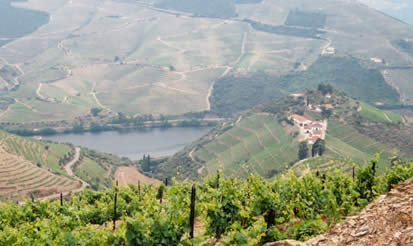
Looking
down on Quinta do Crasto from the vineyards
| In the Douro, driving is a bit of a pain. The road to Crasto
is a particularly long and winding one, and I was feeling a little
green by the end of the journey. However, I was travelling with Jorge
Borges, so I was in good hands: he's a brilliant
driver. [As an aside, Dirk later told me that Jorge had once gone on a
racing event where he got to drive formula 1 cars with the Benetton
racing team. When Dirk rang to ask how it had gone, Jorge told him
that he’d been told off for driving too fast: it turned out that his
times were only fractionally slower than the Benetton test drivers,
much to their embarrassment. Despite the allure of a career in motor
racing, for now it looks like Jorge is sticking to making wine for
Dirk.]
|
n |
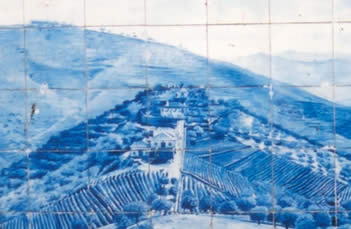
Crasto as depicted in the
famous old tiles at Pinhão railway station |
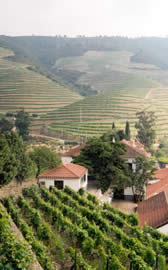
The guesthouse at Crasto
(part-hidden by the tree), with the winery buildings on the
right |
n |
Despite its out-of-the-way location, Crasto is a
breathtakingly beautiful estate, brilliantly situated on top of a
small hill, overlooked by steep sloping vineyards. I’d already met
Tomás Roquette (he’s the technical director here; brother Miguel is
in charge of the marketing) in Porto, and he’d kindly agreed to put
me up in the guesthouse. Over dinner we tried a selection of Crasto
wines, and I asked more questions than is probably polite.
Currently, Crasto boasts 47 ha of vines, and work is underway
planting a further 12 ha. Like many of the Douro properties,
bulldozers are busy carving new terraces out of the hillsides. Of
these, there are 18 ha of old vines that are used to make the Reserva.
Most of the newer plantings are now a respectable 20 years old. There
are also two single vineyards that are used to make special bottlings
in selected years, Maria Theresa and Ponte. In most years there are
also special bottlings of single varietals, so far Touriga Nacional
and Tinta Roriz. Crasto have recently acquired an 80 ha property
further up the river, where it is hotter and drier – plans are to
plant this with another 40 ha of vines. Things are very much on the
move here.
|
|
1997 Douro
Typically 100–150 000 bottles of this fruity Douro wine are made
each year. Impressive herbal-edged nose with red fruits and some
mineral character. The palate is nicely balanced with a savoury edge.
It’s quite ripe with a nice minerally, chalky edge to the herbal
fruit. Mid weight and a nice wine for current drinking. Very good+
1997 Tinta Roriz
The first varietal Tinta Roriz to be released was this 1997. Typically
3–4000 bottles of the single varietal wines are made. This was aged
in 100% new American oak. It has a wonderfully forward sweet nose with
spicy vanilla, sweet fruit and minty coconut notes. The palate is rich
and very concentrated; forward and accessible, but a little too
dominated by the American oak for my palate. Very good+
|
n |
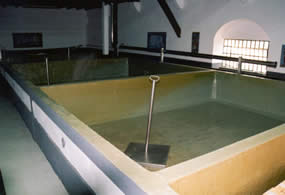
Smart-looking lagares |
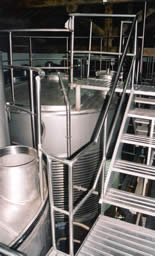
In the winery |
n |
1998 Maria Theresa
This is the first release of this single-vineyard wine. It has a
complex, forward nose of ripe, tarry sweet fruit with complex herbal
elements. The rich, taut palate displays warm, spicy flavours with
more herbal complexity. There’s some tannic structure hiding
underneath the fruit. A very ripe, forward, almost new world style,
but it works very well. Very good/excellent
1995 LBV Port
Crasto have a deservedly good reputation for their late-bottled
vintage port. Typically some 35 000 litres are bottled each year,
although three times this quantity is produced: the balance is sold to
other Port companies. This compares with the 6000 litres of vintage
port produced in 1999. The 1995 is a lovely mature wine with rich,
spicy character and some tannin. Attractive and approachable now,
although the fading colour suggests that you wouldn’t want to hold
this too much longer. Very good+
|
1997 LBV Port
Deep coloured. Attractive
liquoricey and spicy, this is quite serious and structured, with an
attractive herby complexity. A step up from the 1995. Very
good/excellent
| The next morning Tomás took me on a tour of the property
together with new winemaker Susana Esteban – it was only her second
day on the job. Crasto’s wine-producing history is a relatively
recent one. The first Douro wines were produced here in 1994, when
they were made at the Ramos Pinto winery. David Baverstock then began
his involvement here in the 1995 vintage. Baverstock is an Australian
who has spent two decades working in Portugal. His main job is as
winemaker at Esporão in the Alentejo, although he has several
high-profile consulting roles elsewhere.
|
n |
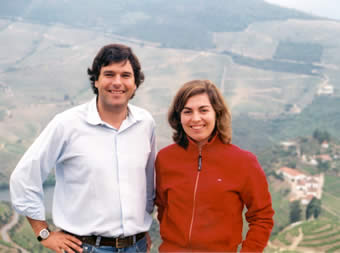
Tomàs Roquette and Susana
Esteban |
In recent years another
Australian, Dominic Morris, has been consulting here. He’s not based
in Portugal, and over the last couple of vintages his involvement has
been somewhat reduced, it seems. However, the arrival of the
aforementioned Susana Esteban is the big news at Crasto. Susana, who
is Spanish, was previously winemaker at another Douro property, Quinta
do Côtto. Everyone I spoke to seemed to regard her very highly, so
look out for further improvement in these already very good wines,
perhaps also with a slight change in style – I for one would welcome
a move away from the rather new-world veneer that these wine have,
with a little less American oak influence.
The winery is pretty much state of the art, with appropriate
traditional touches. There are some lagares, used for the port and
selected table wines if the capacity permits – for example, Maria
Theresa is foot trodden with the stems. These have an elaborate method
of temperature control, which works by circulating the wine through
refrigerated pipes and then back into the lagares. A basket press is
used for pressing the red wines. There’s lots of shiny stainless
steel here: I counted 24 tanks in all, 11 fermentation tanks
(including two open-top fermenters) and 13 storage tanks.
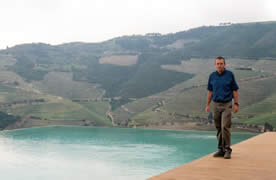
The
author standing by the famous Crasto pool
|
n |
Tomás
also took Susana and I on an extensive tour of the estate,
which is spectacular. We even got to see the famous swimming
pool (whenever I mentioned I'd be going to visit Crasto, this
is the one feature that people commented on: 'don't miss the
swimming pool!'). If it had been a little warmer -- it was
unseasonally cool and overcast -- I'd have been tempted to
jumped in. It looked so inviting, and from the water you can
enjoy uninterrupted views down the Douro. Look for further tasting notes of Crasto wines from the
tasting at Chanceleiros.
|
|

